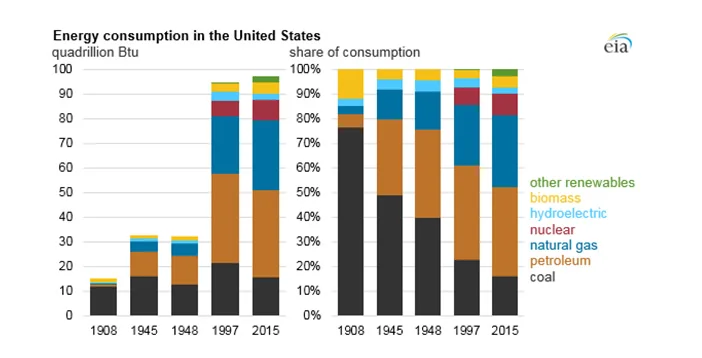At CES we monitor what natural gas is doing in the current market because natural gas and electricity’s prices closely parallel each other. Did you know most natural gas consumed in the U.S. comes from domestic production? We do import a bit of natural gas by pipeline from Canada but because of our own growth in natural gas production we have been able to increase exports of natural gas and are developing more export terminals along the Gulf Coast.
In fact U.S. natural gas production has grown each year since 2006 and continues to grow.
U.S. Energy Consumption
In the U.S. as we head into the winter season the demand goes up and prices of natural gas have started creeping up. But it’s interesting to take a look at energy consumption in the U.S. and where energy is being generated from. It doesn’t just come primarily from coal anymore.
The chart below shows the consumption of energy in the U.S. and where the energy has come from since 1908. Before 1908 the production of energy nationwide wasn’t much of an issue.

Usage has changed dramatically. Back in 1908 crude oil was mainly refined to produce kerosene for use in lamps. In 1908 the first Ford Model T automobile was produced beginning a shift in demand of petroleum products from kerosene for lamps to gasoline for automobiles.
The legend on the right side of the chart above explains the color graph. Coal, petroleum and natural gas are all fossil fuels and have a finite supply. Nuclear energy is a category of its own. The rest of the categories are considered renewables, meaning they come from energy sources that regenerate. The largest source of renewable energy comes from biomass which is yellow on the chart. This is a category of organic materials such as wood, agricultural crops and wastes, landfill gas and more that can be used as a source of fuel or energy.
The category of other renewables includes geothermal (power generated from Earth’s natural steam, hot water, hot rocks or lava in the Earth’s crust), wind, and solar energy.
You can see that petroleum and natural gas have the overall biggest shares of consumption today compared to earlier years when coal had the largest share of consumption.
In 1908 fossil fuels accounted for 85% of total consumption. In 1948 that share increased to 91% as petroleum and natural gas had begun to account for increasing amounts of energy consumption. In recent years the share of fossil fuel consumption has fallen to about 81% of total consumption.
Natural gas became the most prevalent fuel for electricity generation for the first time in April 2015 taking the lead over coal. Generation of electricity fueled by natural gas reached record levels in the summer of 2016. In fact during the first six months of 2016 natural gas supplied 36% of total U.S. electricity generation while coal supplied 31%.
It’s interesting to note that at the beginning of 2016 the price of natural gas was consistently below the cost of coal being delivered to power plants. This was because of the large amount of natural gas in storage and the previous mild winter—which also reduced overall electricity demand. Those low prices of natural gas were reflected in lower electricity prices.
Currently the price of natural gas and coal are running neck and neck and natural gas’s price continues to rise. The prediction is that natural gas will reach its seasonal price peak in February, 2017 and will be about 40% higher than the projected cost of coal for that month. So prices are going up. The main moderating factor at this point is whether we have a mild winter or not.
Because of the prediction that natural gas prices will likely keep rising, coal may once again be used more often to fuel electricity generation than in the recent past. That remains to be seen. But the price of electricity will surely reflect the increasing price of natural gas.
Our energy consultants understand this market and can give you the information you need to make the best energy buying decisions for your home or commercial property. This knowledge can translate to big savings and give you a better handle on energy costs when you have a choice in where to buy your electricity or natural gas from.
Give CES a call today if you are in a deregulated state (866-253-9600) and in very short order we will give you a free rate analysis.
Don’t wait for prices to rise.



